A standby in commercial marine, they’re now being given recreational boating applications

[Editor’s note: Gordon West is an authority on marine electronics and a long-time writer on the subject.]
As every marine electronics dealer knows, there’s a clear distinction between an EPIRB (emergency position indicating radio beacon) for emergencies, and a commercial service provider transponder for status and position updates. But what some may not realize is there’s room for both in the recreational marine marketplace.
The EPIRB, installed aboard a boat, and the smaller personal locator beacon, attached to a mariner’s belt, are internationally recognized satellite signaling devices. They are to be used only as a last resort, when all means of self-rescue have been exhausted.
A commercial service provider radio beacon should never be confused with the lifesaving EPIRB. But neither should the relatively inexpensive commercial units be dismissed as a product you might sell, rent, or install in the recreational market.
The operator of a rental pontoon boat service, for example, can know the whereabouts of his boats at all times. His client can use the device to call for help.
“We operate rental pontoon and go-fast boats here on Lake Meade, and these new $150 SPOT transponders let me see on the Internet a day’s worth of rental locations anywhere on the lake,” said Tom Hall, a rental boat supervisor.
The marine industry has a new portable tool with multipurpose, non-distress capability, which no other satellite beacon system has ever had before.
Commercial service provider beacons have been around for many years in many forms. The latest entry into the field is SPOT, from Globalstar. SPOT (Satellite PersOnal Tracker), a seven-ounce satellite transponder, made its debut at the Miami International Boat Show earlier this year. It transmits its built-in GPS position fix on satellite L band commercial frequencies, near 1615 MHz, spread spectrum, code division multiple access new technology radio techniques. A constellation of 48 Globalstar satellites is capable of receiving and relaying this signal back to multiple Globalstar Earth stations. As many as four Globalstar satellites might pick up a transmission from their low Earth orbits, and as many as three ground stations would receive the relayed position fix and user-selected status message:
• Position and status all OK;
• continuous position string and status, I’m OK;
• position and non-emergency request for help; and
• position and distress message to commercial emergency response center.
With an EPIRB, only distress calls are allowed, and the government takes over. With the commercial service provider, your customer plans his or her messaging:
• Emergency contact phone numbers for 911 authentication;
• 10 Internet and cellular text messaging address, “I’m OK;”
• “help needed” commercial assistance e-mail or cell text message addresses;
• direct connection to commercial emergency response agency (www.geo salliance.com/sar).

SPOT retails for $150, plus an additional $150 yearly fee that covers daily continuous tracking, plus nearly unlimited SPOT e-mail calls to friends and family that your customer is OK, along with his or her position. A simple keystroke or two on the computer by the recipient will display the boat’s position over Google Maps.
Charter companies can rent both EPIRBs and commercial service provider units to keep friends and family up to date on their travels and condition. That charter company would also receive any request for non-emergency assistance.
Anyone with both an EPIRB and SPOT should use only the EPIRB to signal an emergency in remote areas, and the little SPOT emergency 911 button to signal a life-and-death emergency on a small lake patrolled by local rescue teams.
The battery-operated SPOT transponder may be an ideal way of keeping track of your rental boats opting for the “SPOTCASTING” service that updates position every 10 minutes. After 24 hours, this “SPOTCASTING” feature must be re-energized on the equipment, one shortcoming for using this equipment on longer regattas.
This article originally appeared in the September 2008 issue.









